All about graptopetalum
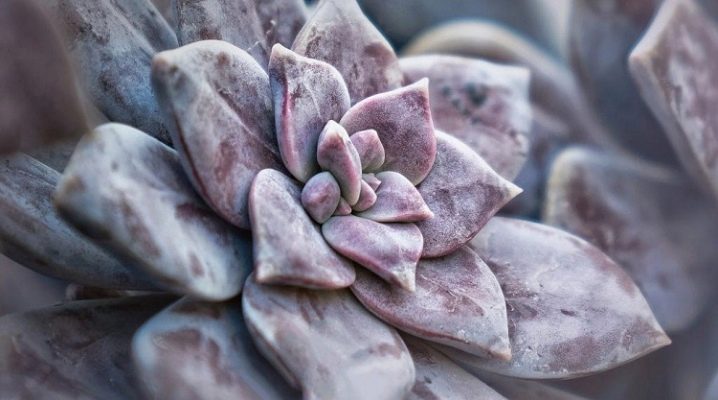
Graptopetalum - Paraguayan and Bellum, Rusbi and Superboom, Amethyst and Filipherum - is a natural succulent that grows in the desert and arid places of North America. Elsewhere, it is highly regarded as an indoor crop with a decorative appearance and gorgeous flowers. A description of the species, life expectancy, planting and care at home will help you learn more about this unusual representative of the bastard family.
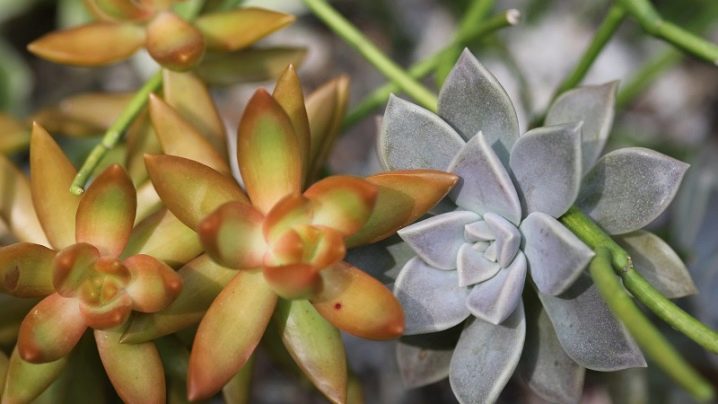
Description
Graptopetalum, also known as spotted petal, is a genus of 20 plant species. This beautiful succulent in nature can reach 85 cm, at home it rarely grows more than 5-25 cm. It forms branchy compact bushes with thickened stems and gnarled leaf rosettes. Some species lack stems. The flower is formed on the arrow, from the buds in the lateral sinuses. The corolla has a star shape, individual petals are lanceolate, their number varies from 5 to 7. Flowering is long, from spring to mid-summer, in periods of 14-21 days. For the shape of the corolla, graptopetalum also received the unofficial name "Mexican Star".
The color of the rosette deserves special attention. It ranges from dusty silver-gray to bluish-green, can have lilac and blue hues. The flowers are more brightly colored, they can have carmine red, pink, crimson tones. Rounded or triangular leaves often have pink pubescence at the ends. Like other succulents, graptopetalum has a fairly long lifespan. With proper care, this perennial shrub can delight the owner for decades.

Popular types
At home, more often than others, several species of spotted petals are grown, as well as numerous hybrids. Of great interest to amateur flower growers are super-boom and filamentous graptopetalum. Among the popular varieties are the following: "Francesco Baldi", "Silver Star", "Vega", "Bronze", "Ellen".
- Paraguayan... Young plants have a straight, thick stem, adults have a creeping structure. The leaves are collected in dense rosettes of a gray-pink hue, their diameter does not exceed 50 mm. Peduncles are short, with stellate white buds covered with dark dots.

- Bellum... The beautiful spotted petal is a compact succulent that forms a flat rosette of blue-colored leaves with a white edging. Pink flowers are formed into bouquets. The stamens are elongated, with white heads. The most popular variety is the "Morning Star"; among the hybrids, the Tacitus bellum form of a cristate with small pink flowers and a purple edging on light green leaves is widespread.
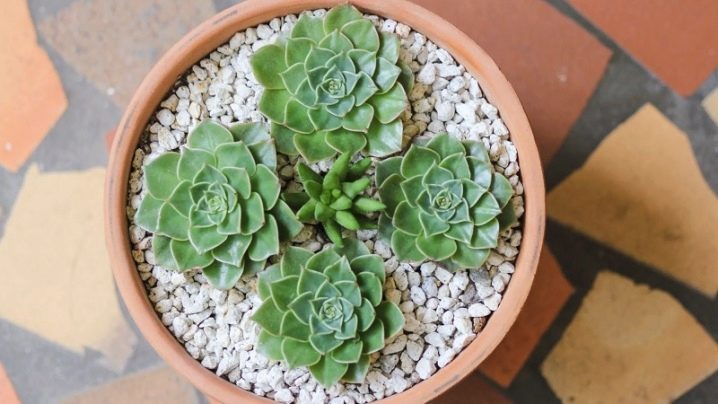
- Filiferum... The filamentous speckle is a beautiful succulent with leaf edges covered with pink villi. The rosette of the flower is rather large, up to 10 cm in diameter, and consists of 100-150 segments. The flowers are large, up to 50 mm, collected in tassels of 4-5 buds.
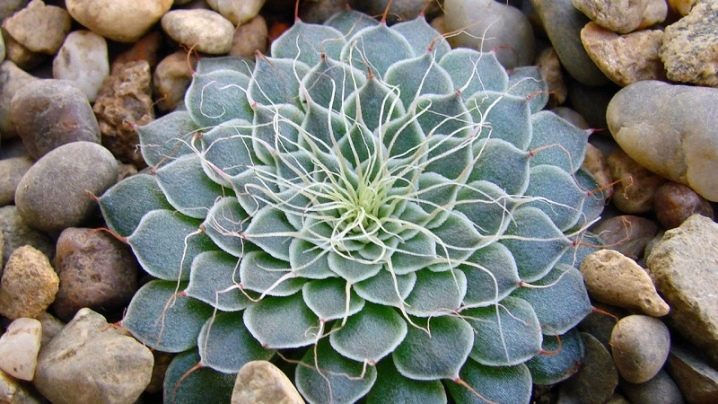
- Rusbi... Also found under the name rushbi. It grows naturally in Mexico and the foothills of Arizona. The rosettes are flattened, consist of diamond-shaped leaves, in an adult bush there are up to 60 of them. The color of the plates is creamy, at the end they have a pointed thorn.
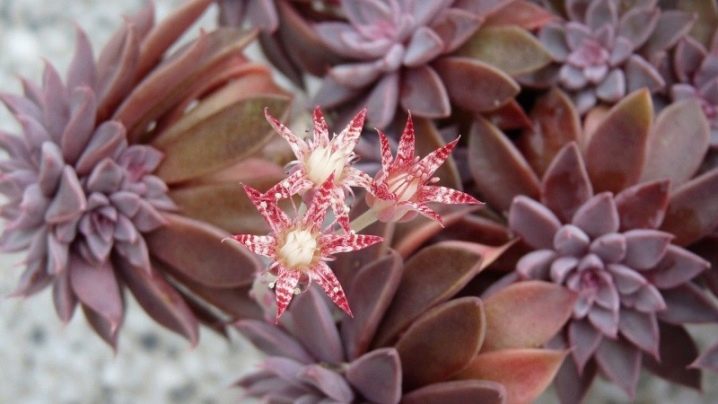
- Amethyst... A plant with lodging shoots and spherical leaves. Their shade is gray-pink, reminiscent of amethyst.Outwardly, the leaves resemble grapes in shape; during flowering, the bush is covered with whitish buds with a red edging.
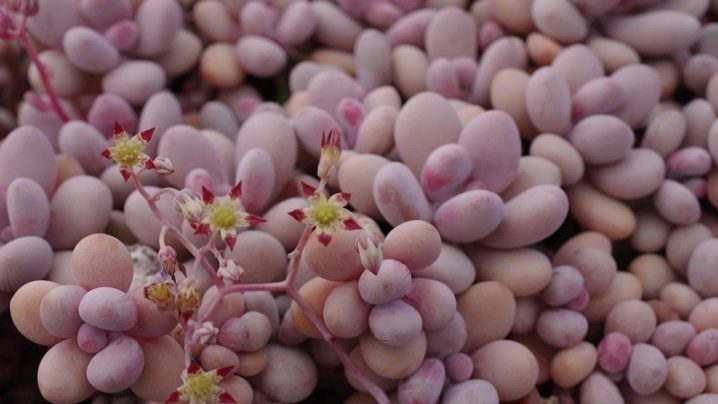
- Thick-leaved... A plant with a fleshy rosette and drop-shaped leaves. Their color is bluish, along the edge there is a purple edging.
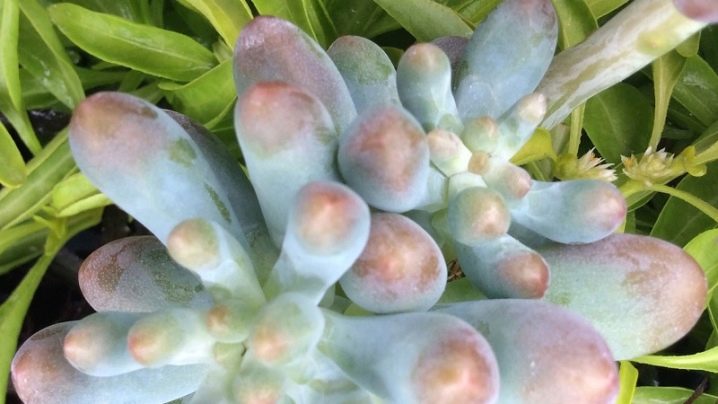
- McDougal. View with bluish rosettes of leaves, very compact, no more than 40 mm. Reproduction occurs with horizontal arrows.
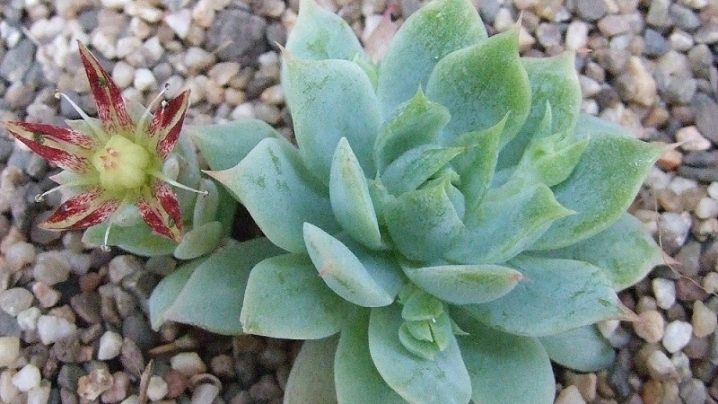
- Five-chained... This spotted petal is compact in size, forms a neat bush covered with silvery-lilac leaves. The stem is straight, with apical rosettes. During flowering, large corollas are formed on long stems with light pink petals and a burgundy border.
Graptopetalum is decorative even during the dormant period. Succulents develop slowly, so you shouldn't expect them to bloom quickly.
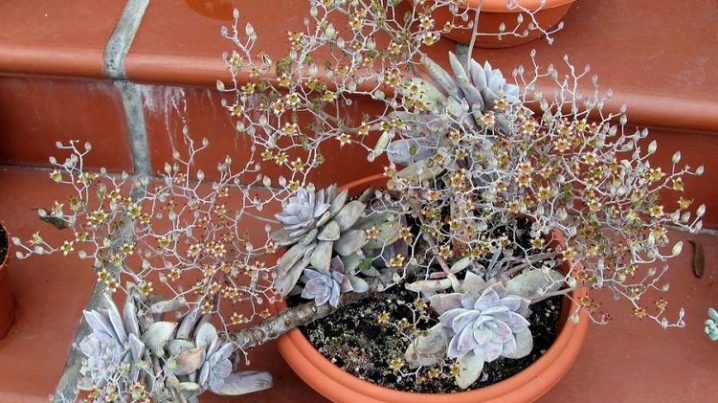
Landing
Graptopetalums are sold on sale in small containers. But at home, after initial acclimatization, it must be transplanted. New young plants obtained from seeds, rooted leaves or cuttings are transferred to a new location in the same way. To do this, you need a spacious, shallow pot with a bottom lined with a thick layer of drainage.
The soil for planting is prepared loose, air and moisture permeable. A ready-made universal substrate for succulents, mixed with 1 part of brick chips and river sand, is suitable. In spring and summer, planting of graptopetalum is carried out with complete cleaning of the roots from the soil, with the extraction of the entire plant from the old substrate. During the dormant period, this procedure requires the use of the transshipment method. The earthen lump is preserved almost completely, only adding fresh soil around the edges.
The order of planting a new plant will be as follows.
- Backfilling with potting soil up to half the pot.
- Plant preparation. It is removed from an old pot or rooting container, dry and damaged roots are cut off.
- Placing a succulent in a pot. You need to straighten the roots so that they are located down the ends.
- Filling the voids. The substrate is poured to the edge of the pot, slightly compacted.
- Adaptation... It takes 1-2 weeks. During this period, they try not to touch the plant, avoid moving it, provide stable lighting and temperature conditions. Then watering and feeding are introduced according to the schedule.
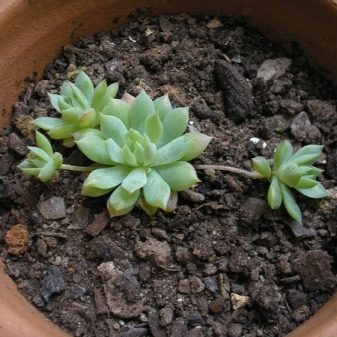
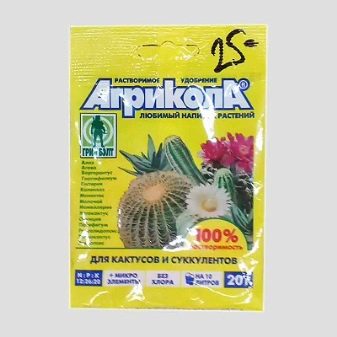
Care
At home, it is quite easy for graptopetalum to create favorable conditions for growth and development. Here are the basic guidelines.
- Correct light mode. The plant should not be exposed to direct sunlight. At the same time, the need for diffused light in graptopetalum is quite high. The plant thrives on a south or southwest window with light shading. In low light conditions, it is recommended to use phytolamps, extending daylight hours up to 10 hours.
- Maintaining optimal temperature. For most of the year, the plant feels comfortable in indoor conditions. But in winter, for the transition to the dormant period, the pot is transferred to a room with a temperature not higher than +10 degrees. Such a change of seasons has a beneficial effect on the growth and development of the succulent.
- Humidity regulation. The culture does well in dry climates in nature. At home, the plant also does not need air humidification. Watering is also carried out in moderation, without overmoistening the substrate, the soil must first dry out to the middle of the pot. After watering, excess moisture must be removed from the pan so that the roots do not rot.
- Top dressing... Fertilization occurs no more than 1 time per month. Any complex for succulents will do. From autumn to spring, during the dormant period, it is not necessary to feed the bushes in pots.
- Soil replacement... It is required only if the succulent root system has become cramped, as well as when the soil is infected with fungi or parasites.You can use a ready-made substrate or make it yourself based on charcoal, turf, sand and garden soil. Frequent soil changes are prohibited, as it is a strong stress factor for the plant.
- Cleaning of fallen leaves. It will avoid the development of rot, deterioration of the air permeability of the substrate.
It is useful to know that in winter, when the plant goes into a dormant period, its watering practically stops. The usual mode of humidification is resumed in spring, when the plant returns to room temperature conditions. Until this moment, watering is carried out once a month.

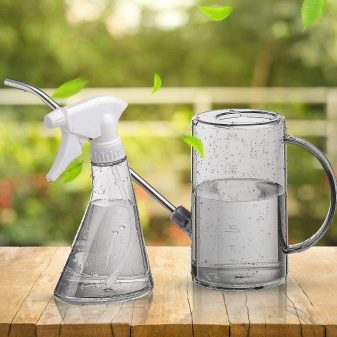
Reproduction methods
Graptopetalum is bred in different ways. You can even grow a new bush as a leaf by simply placing it in water or rooting medium. But the degree of survival of such plantings is markedly reduced. It is much easier to get new seedlings using the following methods.
- Cuttings... The leaf is separated with a sharp sterile scalpel, slightly dried, its bottom is soaked in a rooting stimulator. Then he is placed in a mini greenhouse with sand, but without a film cover. Here the plant develops to the appearance of an independent root system, is watered moderately.
- Seeds... Their germination takes at least a week, and several months pass before the rosettes are formed. Sowing is carried out in moist soil, under a film, and is kept until shoots appear.
- Daughter sockets. The procedure is carried out in spring and summer with the separation of the lateral or apical rosette. The resulting stalk is slightly dried so that a lingering film forms on the cut, treated with sodium humate. Then the rosettes are transferred into peat or sand under a film, a jar, spraying and ventilating the plants as needed. With the appearance of roots, after 2-3 weeks, graptopetalum is transplanted into a permanent pot.
Independent reproduction of spotted petals is quite accessible even for a novice florist. Succulent plants take root well only in loose soils, but the degree of their nutritional value is not so important for seedlings.
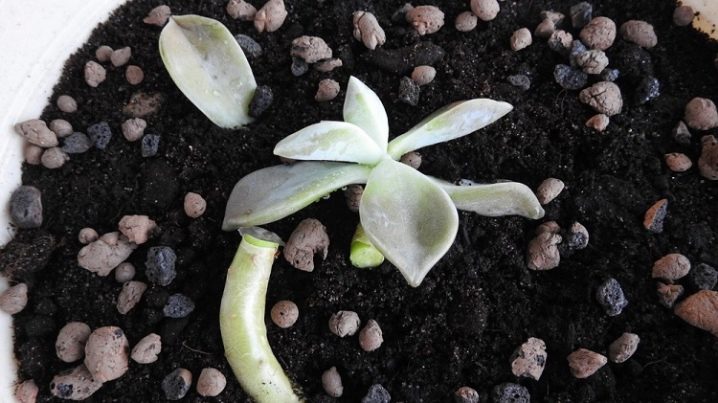
Diseases and pests
At home, graptopetalum rarely suffers from an invasion of pests, but if it appears on other indoor plants spider mite, it is worth checking the condition of the bushes. And also a mealybug can start in the soil. Infected plants are isolated, treated with insecticides, both the shoots themselves and the soil. Among the diseases, the greatest danger to succulents is root rot. It develops on the basis of rosettes or underground shoots. The problem arises from too low air temperature or too much watering. In the process of treatment, all areas affected by rot are cut off, the plant is transferred to a new pot and substrate, and care is normalized.
With a lack of moisture, strong heat, graptopetalum can shed its leaves, they begin to dry and turn yellow. To solve the problem, it is enough to move the pot to a cooler place, increase the frequency of watering. If the leaves are noticeably shredded, they are transplanted into a more spacious container. Proper care can prevent most common diseases. A healthy potted graptopetalum successfully survives periods of flowering and dormancy. Even an inexperienced florist is able to cope with caring for him.
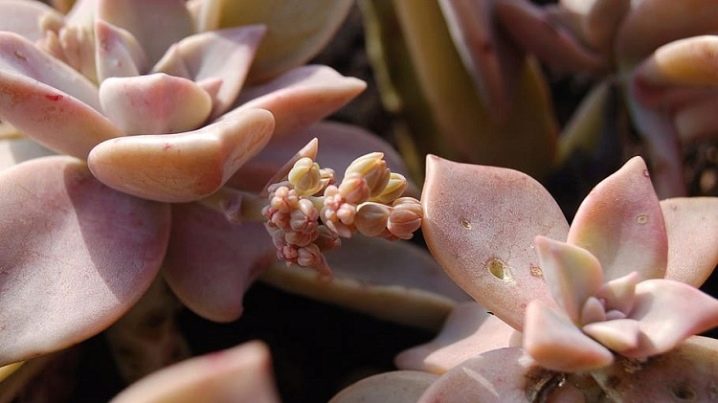























































The comment was sent successfully.